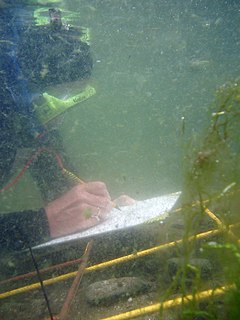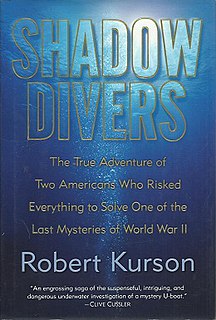
Underwater archaeology is archaeology practiced underwater. As with all other branches of archaeology, it evolved from its roots in pre-history and in the classical era to include sites from the historical and industrial eras. Its acceptance has been a relatively late development due to the difficulties of accessing and working underwater sites, and because the application of archaeology to underwater sites initially emerged from the skills and tools developed by shipwreck salvagers. As a result, underwater archaeology initially struggled to establish itself as bona fide archaeological research. The situation changed when universities began teaching the subject and when a theoretical and practical base for the sub-discipline was firmly established. Underwater archaeology now has a number of branches including, after it became broadly accepted in the late 1980s, maritime archaeology: the scientifically based study of past human life, behaviours and cultures and their activities in, on, around and (lately) under the sea, estuaries and rivers. This is most often effected using the physical remains found in, around or under salt or fresh water or buried beneath water-logged sediment. In recent years, the study of submerged WWII sites and of submerged aircraft in the form of underwater aviation archaeology have also emerged as bona fide activity.
German submarine U-869 was a Type IXC/40 U-boat of the German Navy (Kriegsmarine) during World War II, the wreck of which was discovered off the coast of New Jersey in 1991. Its keel was laid down 5 April 1943 by Deutsche Schiff- und Maschinenbau AG Weser of Bremen. It was commissioned on 26 January 1944 with Kapitänleutnant Helmuth Neuerburg in command. Neuerburg went down with his boat.

Wreck diving is recreational diving where the wreckage of ships, aircraft and other artificial structures are explored. Although most wreck dive sites are at shipwrecks, there is an increasing trend to scuttle retired ships to create artificial reef sites. Diving to crashed aircraft can also be considered wreck diving. The recreation of wreck diving makes no distinction as to how the vessel ended up on the bottom.

The archaeology of shipwrecks is the field of Archaeology specialized most commonly in the study and exploration of shipwrecks. Its techniques combine those of archaeology with those of diving to become Underwater archaeology. However, shipwrecks are discovered on what have become terrestrial sites.

Shadow Divers is a non-fictional book by Robert Kurson recounting of the discovery of a World War II German U-boat 60 miles (97 km) off the coast of New Jersey, United States in 1991.
David A. Bright was an American underwater explorer and diver. He was the president of the Nautical Research Group, which he founded in 2003, and an avid contributor to documentaries on shipwrecks.
John Chatterton is an American wreck diver. Together with Richie Kohler, he was one of the co-hosts for the History Channel’s Deep Sea Detectives, for 57 episodes of the series. He is also a consultant to the film and television industries and has worked with 20th Century Fox, Paramount Pictures, and CBS.
Gary Gentile is an American author and pioneering technical diver.

Sinking ships for wreck diving sites is the practice of scuttling old ships to produce artificial reefs suitable for wreck diving, to benefit from commercial revenues from recreational diving of the shipwreck, or to produce a diver training site.
William "Bill" Nagle (1952–1993) was a pioneering American wreck diver.
"Captain" Billy Deans is a pioneering wreck and technical diver. Although "Captain" is the nickname which is universally applied to Billy Deans, he is in fact a US Coast Guard-rated captain up to 100 tons.

The Sagamore is reported to be the best example of a whaleback barge among Great Lakes shipwrecks. Only 44 whalebacks were ever built, and out of the 26 that sank, only 8 sank in the Great Lakes, most of them being blown up for blocking shipping channels. She sank in 1901 in the shipping lane near the Soo Locks when she was rammed by the steel steamer Northern Queen in one of Whitefish Bay's notorious fogs. Her captain and two crew members went down with her. Artifacts from her wreck were illegally removed in the 1980s. Her artifacts are now the property of the State of Michigan and are on display as a loan to the Great Lakes Shipwreck Museum. The wreck of the Sagamore is protected as part of an underwater museum in the Whitefish Point Underwater Preserve.

The Last Dive: A Father and Son's Fatal Descent into the Ocean's Depths (2000) is a non-fiction book written by diver Bernie Chowdhury and published by HarperCollins. It documents the fatal dive of Chris Rouse, Sr. and Chris "Chrissy" Rouse, Jr., a father-son team who perished off the New Jersey coast in 1992. The author is a dive expert and was a friend of the Rouses.
Michael C. Barnette is an accomplished diver, author, photographer and founder of the Association of Underwater Explorers.
Leigh Bishop is an explorer and deep sea diver known for his deep shipwreck exploration and still underwater photography.

Innes McCartney is a British nautical archaeologist and historian. He is currently a Leverhulme Early Career Fellow at Bournemouth University.
Save Ontario Shipwrecks (SOS) is a Provincial Heritage Organization in Ontario, Canada. SOS is a public charitable organization which operates through Local Chapter Committees supported by a Provincial Board of Directors and Provincial Executive.

The following index is provided as an overview of and topical guide to underwater divers:









